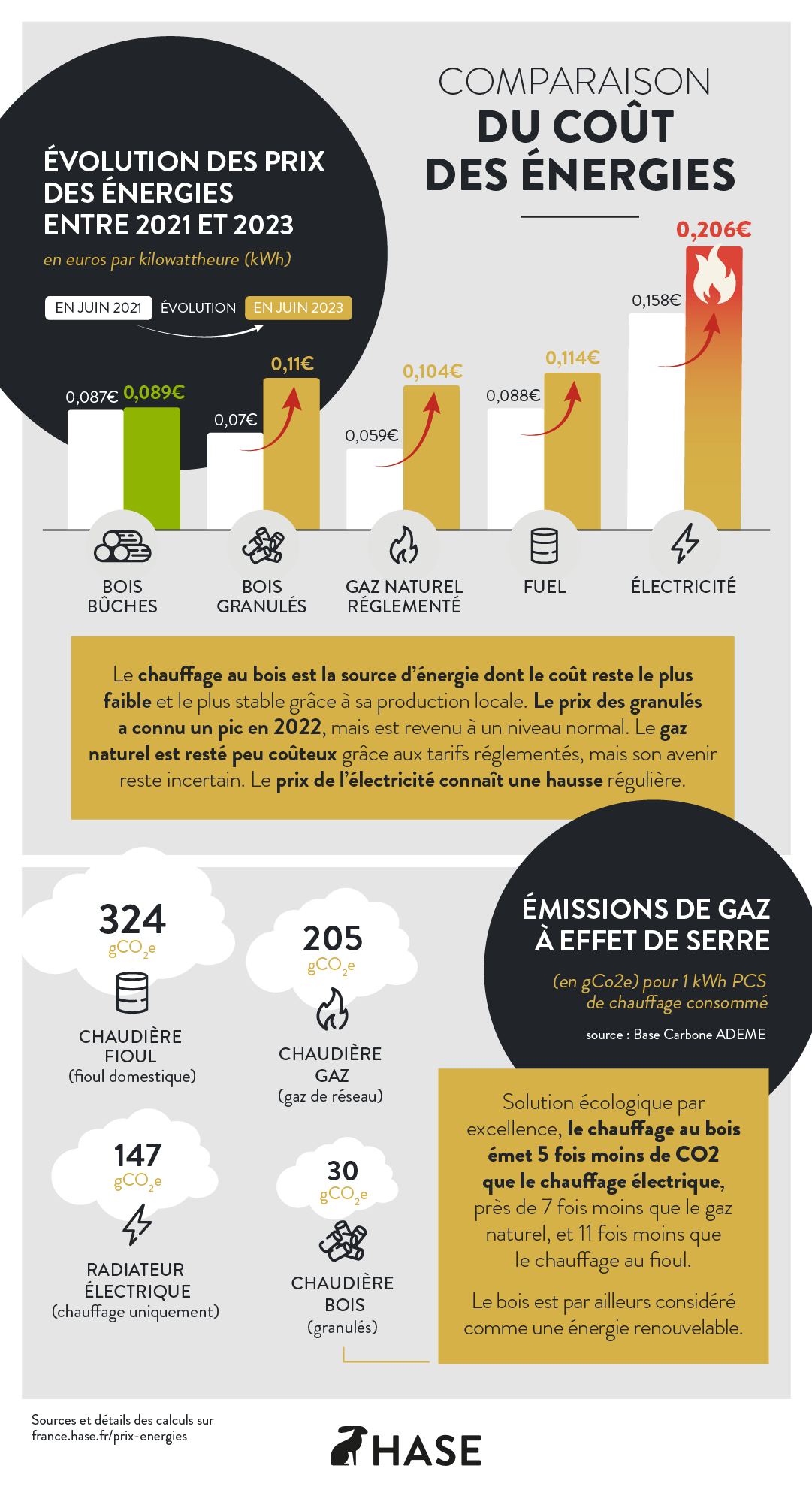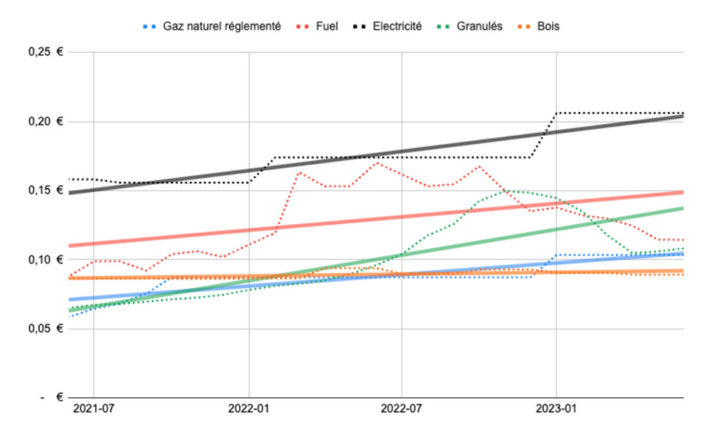Temperatures are dropping, the heating is turning back on, and with energy prices soaring, many are wondering what the cheapest type of heating is. Announcements are multiplying, and between the ecological impact and the prices of different energy sources, the information can sometimes seem contradictory or opaque. Hase, a German manufacturer of wood-burning stoves for over 40 years, has just published a very interesting infographic on the subject, accompanied by figures. A very interesting study, which I'm sharing with you.What is the most economical heating system in 2023?
Wood heating still boasts competitive prices, as it has for many years, and above all, it is the energy source whose price increases the least rapidly and with the least irregularity, even if seasonal variations exist.
For example, wood logs are available for less than 9 euro cents per kilowatt-hour (kWh). Wood pellets are generally priced at around 11 euro cents per kWh.
While there may be regional disparities, the prices of wood logs or pellets remain well below the price of electricity, which now exceeds 20 euro cents per kWh.
The price of fuel oil, like natural gas, now exceeds 10 euro cents per kWh, and is also steadily increasing.
It should also be noted that while the increases in certain energy prices may seem moderate, they are the result of measures put in place by the government, such as the tariff shield, to contain energy inflation and reduce its impact on individuals: it keeps prices artificially low. However, these measures are temporary; the regulated gas tariff was set as of July 1, 2023, and regulated electricity tariffs have already been lifted for some businesses in 2021. They still apply to individuals, but with a 10% increase already in August 2023 and an uncertain future.
Energy prices impacted by the international context

While the war in Ukraine had a significant impact on energy prices in France, as in many other regions of the world, fossil fuels were the most affected by this dramatic event, with international trade disrupted. For their part, logs and wood pellets, local energy sources and therefore less sensitive to international crises, have been more spared by the situation. Their prices depend largely on their region of origin and the labor required to meet demand, even if electricity and fuel are used in their production and transport.
Two-year price trends for various energy sources (in euros including tax/kWh, June 2021 to June 2023), and moving averages over the period
First observation: Wood heating prices are certainly increasing, but to a lesser extent than other energy sources. This increase is mainly based on a slow and more consistent trend than other energy sources.

Like all fossil fuels, fuel oil experienced an increase following the Ukrainian conflict, but like pellets, its price level has returned to a level corresponding to a more “normal” increase.
The regulated gas price allowed consumers to avoid a very sharp increase. It experienced a slight, incremental increase until July 2023, when the regulated rate was abandoned. Its future remains uncertain.
Electricity continues its structural price increase, in the sense that its price level is already promised one, or even several, increases in 2024.
What about the efficiency of heating equipment? While the cost of raw materials is regularly highlighted, it's not the only factor to consider: equipment also plays a significant role in terms of energy efficiency. Efficiency, simply put, is the ratio between the energy generated by the appliance and the energy it consumes.
While it's not possible to achieve 100% efficiency for wood-burning heating, performance continues to improve. Wood-burning stove models with the 7-star Flamme Verte label exceed 75% efficiency, and pellet stoves exceed 87%. Note that the figures provided for gas and fuel oil are based on an estimated efficiency of 100%, but it can vary between 80 and 110% for a gas boiler (conventional or condensing).
As a result, the efficiency difference between wood and other solutions is increasingly narrowing. Choosing wood heating therefore allows for savings compared to other available solutions.
Grants available to reduce the initial investment
As for the equipment price, it represents an initial investment.
The notion of profitability is more long-term, taking into account the foreseeable evolution of energy sources. But… it is difficult to make medium- and long-term forecasts. However, the future of fossil fuels is now numbered, and already high electricity prices only seem set to rise. The only question is: by how much?
Furthermore, regarding the cost of equipment and installation, this can be reduced thanks to grants granted, particularly for wood heating. Grants are available through the MaPrimeRénov' scheme, and it is possible, under certain conditions, to benefit from a reduced VAT rate of 5.5%. In addition, there are energy bonuses and access to the zero-interest eco-loan to finance the acquisition of equipment in connection with other energy renovation work.
Price details measured by energy/source:
Wood: 33-40cm logs on pallets, H1 quality, € per cubic meter including tax, 20% moisture content, not delivered, source CEEB, PCI 1500 kWh/cubic meter.
Pellets: price per ton in bags including tax, not delivered, source CEEB
Fuel: FOD_C1 price including tax, not delivered, official statistics
Electricity: regulated blue tariff, 6 kV, not included in the subscription
- Gas: regulated tariff, B1 tariff, zone 1, not included in the subscription
- What do you think?
- Personally, this analysis doesn't surprise me, as I've been heating with wood for nearly 15 years. But as the manufacturer points out, the price of wood depends greatly on its geographical location. Here in Sologne, a particularly wooded region, a cubic meter of oak, cut and delivered, costs around fifty euros, to give you an idea. Thanks to a high-performance stove, heating costs me less than €500 per year for a house of about 120m², including chimney sweeping. I'd probably find it difficult to spend less. But feel free to give us feedback in the comments about your heating method and your budget for comparison; it's always interesting!
- Source: press release






Please remain courteous: a hello and a thank you cost nothing! We're here to exchange ideas in a constructive way. Trolls will be deleted.